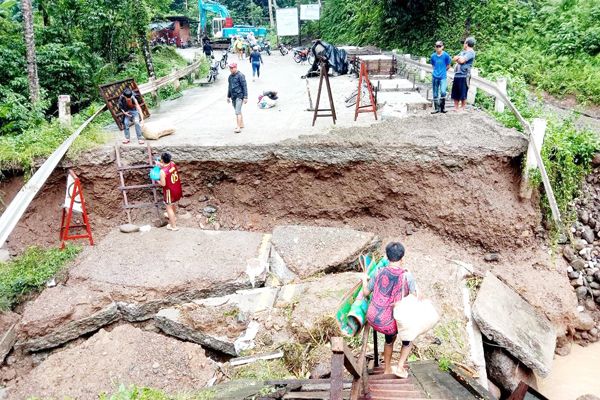By KEITH BACONGCO
DAVAO CITY – Several provinces in Mindanao were flooded on Friday, July 12, and left some road networks temporarily impassable following heavy rain in the last two days.
One of those severely affected was Maguindanao del Norte and parts of Lanao del Sur due to flashflood triggered by heavy rains amid the Intertropical Convergence Zone (ITCZ) since July 10.

RESIDENTS cross a damaged bridge in Barangay Kidayan, Palimbang, Sultan Kudarat on Satuday, July 13. The bridge linking the towns of Kalamansig and Palimbag was damaged due to flooding caused by heavy rains. (Photo courtesy of Sukelco Lebak-Kalamansig)
Reports showed that at least five persons were reportedly killed in the flashflood while seven others remain missing as of Saturday morning, July 13.
The Bangsamoro Autonomous Region in Muslim Mindanao (BARMM) Rapid Emergency Action on Disaster Incidence (READi) disclosed that 19 individuals were injured in the flashflood.
It added that the flooding also affected at least 4,000 residents in Matanog, Maguindanao del Norte.
A portion of the Narciso Ramos National Highway in Balabagan, Lanao del Sur, which links the towns within BARMM and to Zamboanga Region, was temporarily closed to traffic as of 6:40 p.m. on July 12. As of 11 a.m. on July 13, the highway remains closed to traffic.
The severe flooding also affected the neighboring town of Kapatagan in Lanao del Sur.
The highway linking Wao town, also in Lanao del Sur, and Kalingangan in Bukidnon province, was also temporarily closed at 9:45 p.m. on Friday due to a landslide.
It was cleared and declared passable at 1:30 a.m. on July 13, according to the Provincial Disaster Risk Reduction and Management Office of Lanao del Sur.
On Friday evening, the PDRRMO issued an orange warning over Lanao del Sur, which means there could be about 75,000 to 150,000 drums of rain per square kilometer in the province.
The Philippine Atmospheric, Geophysical, and Astronomical Services Administration (PAGASA) issued a weather advisory at 11 p.m. on July 12 stating that the southwest monsoon will bring heavy to intense rains (100 to 200 millimeters) over BARMM, Zamboanga Peninsula, Sultan Kudarat, Misamis Occidental, and Lanao del Norte until Saturday night.
Severe flooding and landslides were reported in some barangays in the coastal towns of Lebak, Kalamansig, and Palimbang, Sultan Kudarat province on Friday.
As of 10 a.m., the Department of Public Works and Highways-12 reported that the Kalamansig-Palembang Road remains unpassable due to landslides and damaged bridge in Barangay Santa Clara in Kalamansig.
The Kalamansig-Lebak Road, which was briefly closed on Friday night, is now passable after the DPWH cleared the road of debris following a landslide in Barangay Bolebak on Friday.
In the neighboring province of Sarangani, some rice farms in Kiamba were swamped by floodwaters since Friday due to heavy rains.
In Zamboanga City, the local government reported on its Facebook page that about 3,000 individuals from 11 barangays were evacuated to higher grounds due to severe flooding on Friday.
At 6:34 a.m. on Saturday, the city government announced that flights to the city have been suspended due to flooded runway.
On Friday evening, some areas of Cotabato City were also submerged in floodwater.
These severe weather disturbances took place just as PAGASA issued a La Niña alert on Friday stating that its climate monitoring and analyses suggested a 70 percent chance of La Niña forming in August-September-October (ASO) 2024 season and is likely to persist until the first quarter of 2025.
This was due to further cooling of the sea surface temperatures (SSTs) across the central and eastern equatorial Pacific (CEEP), it added.
“With this development, the DOST-PAGASA ENSO Alert and Warning System is now raised to La Niña alert,” PAGASA said.
“The country may experience a higher chance of increased convective activity and tropical cyclone occurrence which may bring above normal rainfall over some parts of the country in the coming months. Potential adverse impacts may include floods and landslides over vulnerable areas, with varying magnitude.”